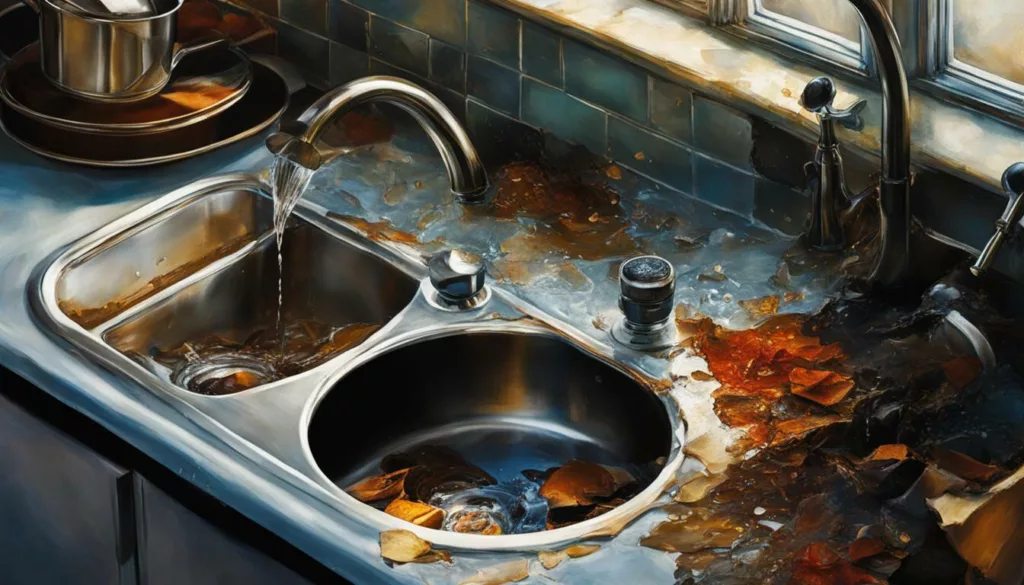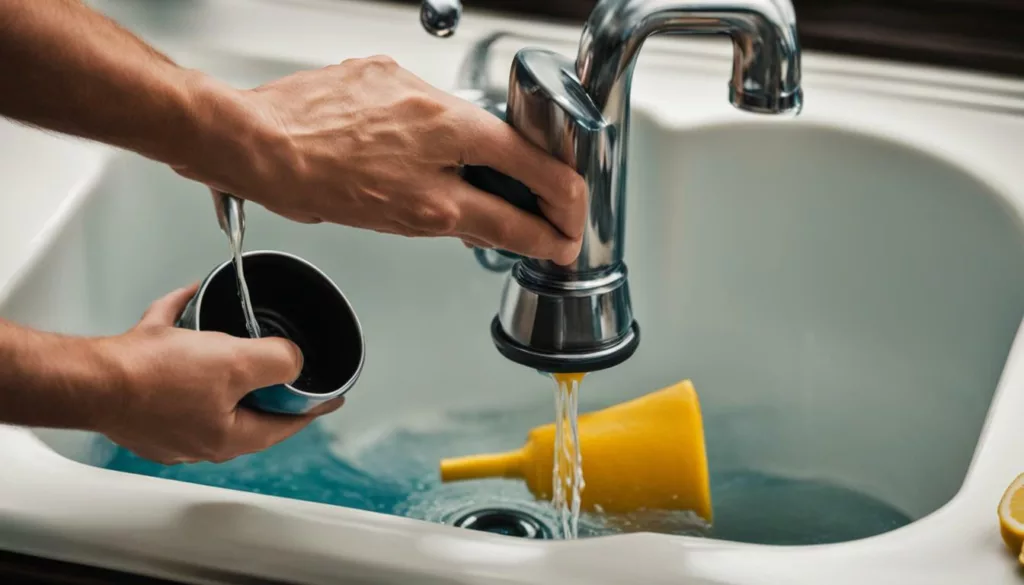How To Unclog A Kitchen Sink Effectively
If you’re dealing with Unclog A Kitchen Sink, you’re not alone. It’s a common issue that can be caused by a variety of factors, such as food waste, grease build-up, and foreign objects. Not only is a clogged sink frustrating, but it can also be a health hazard.
Don’t worry, though – you don’t need to be a professional plumber to unclog your kitchen sink. With the right tools and knowledge, you can tackle this problem and get your sink back to its free-flowing state. In this comprehensive guide, we’ll share 11 expert tips to help you effectively Unclog A Kitchen Sink.


- Unclog A Kitchen Sink can be done with DIY methods
- Preventive measures can help avoid future clogs
- If DIY methods fail, calling a professional plumber is the best option
- There are multiple methods to unclog a kitchen sink that require different tools and techniques
- Following the right procedure can ensure the success of the method applied
Plunge the Kitchen Sink
When it comes to Unclog A Kitchen Sink, the plunger is a classic tool that can be quite effective. This method works by creating pressure that loosens and dislodges clogs in the drain. To use this method, follow these steps:
- Fill the sink halfway with water.
- Place the plunger over the drain and press down firmly to create a tight seal.
- Pull up and down on the plunger vigorously to create suction and pressure.
- Repeat this process until the clog is dislodged and the water drains freely.
If the plunger method doesn’t work, try again after applying petroleum jelly to the rim of the plunger to create a stronger seal.


It’s important to note that the plunger method may not work for all types of clogs. If the clog is particularly stubborn, you may need to use additional methods.
Use Boiling Water to Unclog A Kitchen Sink
If your kitchen sink is draining slowly or not at all, one effective and simple method to try is using boiling water. This method is best suited for sink clogs caused by grease or food buildup.
To use this method, first, clear any standing water in the sink. Then, heat a pot of water on the stove until it reaches a rolling boil.
When the water is ready, carefully pour it down the drain in increments of 2-3 cups at a time, allowing each addition to work its way through the clog before adding more.


Be cautious when handling boiling water to avoid burns and only attempt this method on metal or ceramic sinks, as plastic sinks may melt or warp from the high temperatures. Additionally, do not use boiling water on sinks with PVC pipes, as it may soften or damage the pipes.
Using boiling water can be a quick and effective solution to unclog A Kitchen Sink, but if the clog persists, it may require another method, such as using a plumber’s snake or calling a professional plumber.
Check the Garbage Disposal
If you have a garbage disposal, it can be a major contributor to a clogged kitchen sink. Before attempting any other method, it’s important to check your garbage disposal for any potential issues. Start by turning off the disposal and unplugging it to avoid any accidents.
Next, use a flashlight to inspect the disposal for any visible blockage. If you notice anything, use pliers or tongs to carefully remove the debris. Be careful not to touch the blades with your fingers as they can be sharp and cause injury.
If you don’t notice any obvious debris, try running water through the disposal to see if it drains properly. If the water doesn’t drain or drains slowly, it’s likely that the disposal is clogged further down the line.
You can try using a garbage disposal cleaner or lemon peels to freshen up your disposal and prevent future clogs. If the clog persists, it’s best to call a plumber for further inspection and repairs.


If you prefer an all-natural approach to unclogging your kitchen sink, using a baking soda and vinegar mixture might be worth a try. This combination can be an effective alternative to chemical-based drain cleaners.
To create the mixture, start by pouring a pot of boiling water down the drain. Follow this by pouring 1/2 cup of baking soda into the sink and then slowly pour 1/2 cup of white vinegar down the drain. You may notice bubbling and fizzing as the vinegar reacts with the baking soda. Allow the mixture to sit for 15 minutes or until the fizzing stops.
After 15 minutes, pour another pot of boiling water down the drain to flush away the loosened clog. If the clog persists, repeat the process until the sink is unclogged.


Remember to use caution when using this method, and avoid using this method if you have already used a chemical drain cleaner. Combining chemical cleaners with baking soda and vinegar can cause dangerous chemical reactions.
Try the Plumber’s Snake
If the previous methods have failed to unclog your kitchen sink, it may be time to try a plumber’s snake. This tool is designed to reach deeper into the pipe and break up or dislodge stubborn clogs.
To use a plumber’s snake, start by removing the sink stopper and inserting the end of the snake into the drain. Then, turn the handle clockwise to extend the snake further into the pipe. When you encounter resistance, continue turning the handle to break up or dislodge the clog. Once the clog has been cleared, pull the snake back out of the drain.
It’s important to note that plumber’s snakes can cause damage to your pipes if not used correctly, so use caution and follow the instructions carefully. If you are unsure about using a plumber’s snake, it may be best to call a professional plumber.


Tip: Avoid using chemical drain cleaners with a plumber’s snake, as the chemicals can cause damage to the snake and your pipes.
Clean the P-Trap
One of the most common places for a kitchen sink clog is in the P-trap, which is located beneath the sink. The P-trap can easily become clogged with debris, causing water to back up into the sink.
To clean the P-trap, first, turn off the water supply to the sink. Place a bucket beneath the P-trap to catch any water or debris that may fall out.
Next, use a wrench to loosen the slip nuts on each side of the P-trap and remove it. Be cautious as water and debris may fall out. Use a cleaning brush to scrub the inside of the P-trap and remove any clogs or buildup.
After cleaning, reassemble the P-trap and turn on the water supply to the sink. Check for any leaks before using the sink again.
Cleaning the P-trap can be a simple and effective way to unclog your kitchen sink. It’s important to regularly clean the P-trap to prevent future clogs and keep your sink running smoothly.


If other methods fail to unclog your kitchen sink, using a wet-dry vacuum can be a powerful way to dislodge the blockage. This method works by creating suction to pull the clog out of the pipe. Make sure to use a vacuum that has a wet-dry feature, as regular vacuums are not designed for this task.
Start by removing the vacuum filter to prevent it from clogging. Then, place the vacuum nozzle over the drain and create a tight seal around it. Turn on the vacuum to create suction, and let it run for a few minutes.
If the clog does not come loose after a few minutes, try shifting the nozzle around in different directions to create different angles of suction. You may also want to try using a plunger to further loosen the clog before attempting to use the vacuum again.
| Pros | Cons |
|---|---|
| Powerful suction can remove stubborn clogs | May require multiple attempts |
| Does not require harsh chemicals | Requires a wet-dry vacuum, which not everyone may have |
| Can be a quick and easy solution if the clog is not too severe | May not work for all types of clogs |
Remember to always be cautious when using a wet-dry vacuum to avoid causing damage to your sink or pipes.


Next up: if the clog persists, try using an auger on the upper part of the pipe to dislodge it.
Use an Auger on the Upper Part of the Pipe
If your kitchen sink remains clogged, it’s time to try a plumber’s auger. This tool can reach deep into the pipe to dislodge any stubborn clogs.
To start, insert the auger into the sink drain and twist it slowly clockwise. Keep rotating the auger until you reach the obstruction. Once you feel the auger hit the clog, start twisting it counterclockwise. This movement should break up the blockage so that you can remove it from the sink.
Be mindful not to use too much pressure while using the auger, as this can damage your plumbing system. If you’re unsure how to use an auger safely, consider hiring a professional plumber to help you.


When using the auger, make sure to wear protective gloves to avoid injury or contamination. Remember that this tool can only be used on the upper part of the pipe, so if the clog persists, you may need to try another method or call a professional plumber to resolve the issue.
Use an Auger on the Trap and Wall Pipe
If the clog in your kitchen sink persists despite your previous attempts, you may need to use an auger on the trap and wall pipe. The trap is the S- or P-shaped curved pipe located beneath your sink, while the wall pipe connects the trap to the main drain pipe.
Using an auger in these areas requires some skill and caution to prevent damaging your pipes. Begin by removing the trap and cleaning it out. Then, insert the auger into the wall pipe and gradually work it down the line. Continue turning the auger until you feel it break through the clog and the water begins to flow freely.
Remember that using an auger can be dangerous and may cause damage to your pipes if not done correctly. If you are unsure about how to use an auger on the trap and wall pipe, it’s best to call a professional plumber.


Using an auger on the trap and wall pipe is an effective way to clear stubborn clogs in your kitchen sink. However, it’s important to exercise caution and only attempt it if you are confident in your abilities. If you’re unsure or the clog persists, don’t hesitate to call a professional plumber for assistance.
Take Measures to Prevent Clogs
Now that you’ve successfully unclogged your kitchen sink, it’s important to take measures to prevent future clogs. Here are some tips:
- Don’t pour grease or oil down the drain. These substances solidify and can cause blockages.
- Use a drain strainer to catch food scraps and other debris before they enter the drain.
- Regularly clean your sink with hot water and soap to prevent build-up.
- Run hot water down the drain after each use to prevent grease and oil from accumulating.
- Avoid washing materials that can expand and cause blockages, such as rice and pasta.
By following these preventive measures, you can avoid future kitchen sink clogs and keep your sink running smoothly.


If you’ve exhausted all the DIY methods and your kitchen sink is still clogged, it may be time to call a professional plumber. Attempting to fix the issue yourself may cause more damage, resulting in costly repairs.
A plumber has specialized tools and expertise to locate and remove the clog safely. They can also inspect your pipes and provide recommendations on how to prevent future clogs.


Don’t hesitate to call a plumber when you need one. It’s better to have the job done right the first time and avoid further complications.
If you’re experiencing frequent sink clogs, it could be a sign of a more significant underlying issue. Trying to fix it yourself could make things worse and require costly repairs. Contact a professional plumber to fix the issue and ensure your kitchen sink runs smoothly.
Conclusion
By following these 11 expert tips, you can successfully unclog your kitchen sink without the need for professional help. Remember to keep preventive measures in mind to avoid future clogs.
Regularly check and clean your sink, garbage disposal, and P-trap to prevent the buildup of debris. Avoid pouring grease, oil, and large food particles down the drain. Instead, dispose of them in the trash or compost. Use a drain strainer to catch any small particles that may cause clogs.
If you’ve exhausted all DIY methods and the clog persists, don’t hesitate to call a plumber. They have the tools and expertise to resolve even the most stubborn clogs.
By staying proactive about your kitchen sink maintenance and knowing how to unclog it effectively, you can save time and money in the long run. So, remember these tips and keep your kitchen sink running smoothly!
Happy Learning
Also, Read,
Stylish Frameless Shower Doors
Euro Pillow – Upgrade Your Sleep
FAQ
What is the purpose of this guide?
The purpose of this guide is to provide you with expert tips on how to effectively unclog your kitchen sink.
What are the common issues that can lead to a clogged kitchen sink?
Common issues that can lead to a clogged kitchen sink include food debris, grease buildup, and foreign objects.
How do I plunge the kitchen sink?
To plunge the kitchen sink, you should place a plunger over the drain, ensuring a tight seal, and then push and pull the plunger forcefully to create suction and dislodge the clog.
How can I use boiling water to dislodge a sink clog?
Using boiling water involves carefully pouring a kettle or pot of boiling water down the drain to dissolve and dislodge the clog.
How do I check the garbage disposal for potential clogging issues?
To check the garbage disposal, you should turn off the power, inspect the disposal for visible debris or blockages, and manually rotate the blades to ensure they are moving freely.
How can I dissolve a clog with a baking soda and vinegar mixture?
To dissolve a clog with a baking soda and vinegar mixture, you should pour half a cup of baking soda followed by half a cup of vinegar down the drain, cover it, and let it sit for around 30 minutes. Then flush the drain with hot water.
How do I use a plumber’s snake?
To use a plumber’s snake, insert the end into the drain and rotate the handle clockwise while pushing it forward. Keep feeding the snake until you encounter resistance, then twist and push to dislodge the clog.
How can I clean the P-trap?
To clean the P-trap, place a bucket or container beneath it to catch any water, then unscrew the trap using a wrench. Remove any debris or blockages and reassemble the trap.
How do I use a wet-dry vacuum to clear the sink?
Using a wet-dry vacuum involves covering the vent opening, creating a tight seal with the hose, and applying suction to dislodge the clog.
How can I use an auger on the upper part of the pipe?
To use an auger on the upper part of the pipe, insert the auger into the drain until you encounter resistance, then twist and push to break through the clog. Retrieve any debris and repeat if necessary.


How do I use an auger on the trap and wall pipe?
Using an auger on the trap and wall pipe involves removing the trap, inserting the auger into the pipe, and rotating and pushing it to dislodge the clog. Retrieve any debris and reassemble the trap.
What preventive measures can I take to avoid future clogs?
To prevent future clogs, you should avoid disposing of grease and large food particles down the drain, use a sink strainer to catch debris, and regularly clean and maintain your garbage disposal.
When should I call a plumber?
If you’ve tried all the DIY methods and the clog persists, it’s appropriate to call a professional plumber to assess and resolve the issue.



